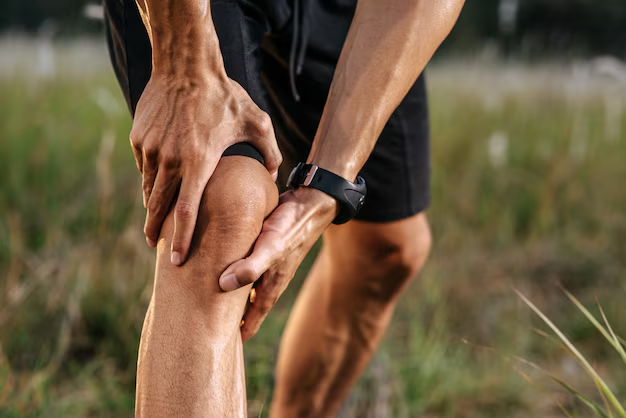Move Free Joint Health are the hinges that allow you to move, bend, stretch, and live life with ease. From walking and climbing stairs to typing on a keyboard and lifting groceries, healthy joints are essential to everyday functioning. But as we age—or due to poor lifestyle habits—joint pain, stiffness, and inflammation can start to interfere with our mobility and quality of life. Fortunately, with the right habits and preventive care, you can move free and maintain optimal joint health well into your golden years.
In this article, we’ll explore what joint health means, why it matters, what causes joint deterioration, and the top 8 evidence-backed tips to protect and strengthen your joints for a more active, pain-free life.
What Is Joint Health and Why Does It Matter?

Maintaining strong, flexible joints is essential for living an active and pain-free life. Your joints are responsible for every movement—from walking and bending to lifting and stretching—making joint health an essential part of overall wellness. But what exactly is joint health, and why does it matter so much?
Joint health refers to the condition of your joints, including bones, cartilage, ligaments, and synovial fluid, which all work together to support smooth and pain-free movement. When joints are healthy, you move easily and freely. However, aging, inflammation, injuries, sedentary habits, and excess weight can all lead to joint deterioration, resulting in stiffness, pain, and reduced mobility.
That’s where move free joint health becomes a powerful goal—maintaining joint strength and flexibility to enjoy life without limitations. Whether you’re trying to prevent problems or already experiencing joint discomfort, proactive care is key.
In this article, we’ll explore the top 8 evidence-based strategies to support move free joint health, including proper nutrition, regular low-impact exercise, healthy weight management, hydration, and injury prevention. By incorporating these practices into your lifestyle, you can protect your joints, reduce inflammation, and stay active at every stage of life.
Maintaining move free joint health is not just about preventing pain—it’s about preserving independence, staying physically active, reducing the risk of arthritis, and avoiding joint-replacement surgeries. Strong joints support strong movement—and movement is medicine.
Common Causes of Poor Joint Health
Understanding what can harm your joints helps you take early action. Here are the most common culprits:
- Aging – Natural wear and tear on joints and cartilage loss
- Inactivity – Lack of movement causes stiffness and weakens support muscles
- Obesity – Extra weight puts added pressure on joints, especially knees and hips
- Poor posture – Misalignment stresses joints unnecessarily
- Injuries – Repeated stress or sudden trauma can cause lasting damage
- Inflammation – Chronic inflammation can wear down cartilage
- Nutrient deficiencies – Lack of certain nutrients affects joint and bone health
Now let’s dive into the top 8 tips to improve move free joint health naturally and sustainably.
✅ Tip #1: Keep Moving – But Smartly
Movement is crucial for maintaining joint flexibility, strength, and overall move free joint health. Our joints are designed for motion, and without regular activity, they become stiff, weak, and prone to discomfort. Consistent, gentle movement helps lubricate joints, strengthens surrounding muscles, and improves circulation. However, it’s important to choose joint-friendly exercises like walking, swimming, stretching, or yoga that minimize stress and reduce wear and tear. Avoid high-impact activities that can damage cartilage or strain ligaments. Prioritizing safe, regular movement is one of the most effective ways to preserve move free joint health and stay active throughout life.
Best activities for joint health:
- Low-impact exercises like walking, swimming, biking, or yoga
- Range-of-motion exercises to improve flexibility
- Strength training to build muscles that support your joints
Avoid: High-impact workouts that jar the joints (e.g., intense jumping, running on hard surfaces), especially if you already have pain or injury.
Consistency is key. Try to stay active for at least 30 minutes a day, 5 days a week.
✅ Tip #2: Maintain a Healthy Weight

Maintaining a healthy weight is essential for move free joint health. Every extra pound you carry puts an additional 4 pounds of pressure on your knees, placing significant strain on your joints. Over time, this excess stress can accelerate the wear and tear on cartilage, increasing your risk of developing joint problems like osteoarthritis. Shedding even a small amount of weight can greatly reduce joint stress, relieve pain, and slow joint degeneration. By combining a balanced diet with low-impact exercise, you support move free joint health and give your joints the relief they need to stay strong and flexible
Maintaining a healthy weight is a key step in supporting joint health, and it’s where Move Free Joint Health begins its focus. Excess body weight places additional stress on joints—especially the knees, hips, and lower back—leading to faster wear and tear. By managing your weight through a balanced diet and regular physical activity, you can significantly reduce joint pressure, improve mobility, and ease discomfort.
Move Free Joint Health supplements are designed to complement these lifestyle efforts. They often include important ingredients like glucosamine, chondroitin, hyaluronic acid, and MSM, which work together to nourish cartilage, support cushioning between joints, and enhance flexibility. These ingredients help your joints stay lubricated and mobile, making daily activities easier and more comfortable.
Combining weight management with targeted joint support can produce even greater benefits. Whether you’re walking, gardening, or staying active in other ways, lighter body weight and stronger joints make movement less painful and more enjoyable. For best results, take Move Free supplements as directed and pair them with healthy habits like staying hydrated, eating anti-inflammatory foods, and engaging in low-impact exercise. Always consult a healthcare professional before beginning any supplement routine, especially if you have existing medical conditions or take other medications.
Ways to support a healthy weight:
- Eat a balanced, anti-inflammatory diet
- Stay active and avoid sedentary behavior
- Monitor your BMI and waist circumference
Even losing 5–10% of your body weight can significantly reduce joint pain and stiffness.
✅ Tip #3: Eat an Anti-Inflammatory Diet
Inflammation is a major contributor to joint pain and stiffness, making it a critical factor in maintaining move free joint health. Following an anti-inflammatory diet—rich in fruits, vegetables, whole grains, omega-3 fatty acids (like those found in salmon and flaxseeds), and healthy fats like olive oil—can significantly reduce joint swelling and discomfort. These foods help lower inflammatory markers in the body, protect cartilage from damage, and improve overall joint flexibility. Limiting processed foods, refined sugars, and trans fats is equally important. By adopting an anti-inflammatory eating pattern, you support long-term move free joint health and enhance your mobility..
Foods that support move free joint health:
- Fatty fish (salmon, sardines, mackerel): Rich in omega-3s
- Leafy greens (spinach, kale, collard greens)
- Berries (blueberries, strawberries): Loaded with antioxidants
- Nuts and seeds (especially walnuts and flaxseeds)
- Olive oil: A healthier fat alternative
Avoid: Processed foods, refined sugars, red meats, and trans fats, all of which increase inflammation and joint stress.
✅ Tip #4: Support Your Joints with the Right Nutrients
Certain vitamins and minerals play a critical role in joint strength, cartilage repair, and flexibility.
Top nutrients for joint health:
- Vitamin D – Supports calcium absorption and bone strength
- Calcium – Builds strong bones that support joints
- Magnesium – Relieves muscle tightness and reduces cramping
- Collagen – A structural protein in cartilage and joints
- Glucosamine & Chondroitin – Found in many Move Free joint supplements, these can help rebuild cartilage and reduce pain
Tip: Get these nutrients through food or consider a doctor-recommended supplement if you’re deficient.
✅ Tip #5: Stay Hydrated
Joint cartilage is composed of up to 80% water, making proper hydration a key factor in maintaining move free joint health. Water helps cushion the joints, supports nutrient delivery to cartilage, and flushes out toxins that can contribute to inflammation. When you’re dehydrated, cartilage can dry out and become less effective at absorbing shock, increasing joint stiffness and discomfort. Drinking enough water throughout the day ensures that your joints stay lubricated and function smoothly. Prioritizing hydration is one of the simplest yet most effective steps you can take to support long-term move free joint health and prevent joint-related issues.
Benefits of water for joints:
- Lubricates joints for smooth movement
- Flushes out toxins that trigger inflammation
- Maintains the shock-absorbing property of cartilage
Aim for 8–10 glasses of water a day, more if you’re active or live in a hot climate.
✅ Tip #6: Improve Posture and Ergonomics
Poor posture places unnecessary stress on your joints, particularly in the spine, hips, and knees, compromising move free joint health. Slouching or improper alignment can lead to muscle imbalances, joint stiffness, and chronic discomfort over time. When your posture is off, certain joints are forced to overcompensate, accelerating wear and tear and increasing the risk of joint degeneration. Maintaining good posture helps distribute your body weight evenly, reduces strain on connective tissues, and promotes smoother joint function. Practicing proper alignment, whether sitting, standing, or lifting, is essential to protect your joints and support long-term move free joint health
Tips for better joint alignment:
- Sit with feet flat on the floor and back supported
- Adjust computer screens to eye level
- Use ergonomic chairs and supportive footwear
- Avoid slouching or crossing legs for long periods
Proper posture supports spinal health and allows joints to work efficiently, reducing wear and tear.
✅ Tip #7: Avoid Joint Injuries
An injury today can easily turn into a long-term issue that affects your ability to move comfortably. To support move free joint health, it’s essential to protect your joints during any physical activity. Always warm up properly, use correct techniques, wear appropriate gear, and avoid pushing your body beyond its limits. Small strains or sprains, if ignored, can lead to chronic pain, inflammation, or even arthritis. Whether you’re exercising, lifting heavy objects, or playing sports, being cautious helps preserve joint function and mobility. Prioritizing joint safety today ensures pain-free, flexible movement for years to come and promotes lasting move free joint health..
Joint injury prevention tips:
- Warm up and stretch before exercise
- Use proper form during strength training
- Wear supportive shoes with shock absorption
- Avoid overtraining—rest is essential
- Use protective gear for sports or labor-intensive work
If you have an old injury, work with a physiotherapist to strengthen surrounding muscles and prevent reinjury.
✅ Tip #8: Listen to Your Body and Rest When Needed

Pain is your body’s way of signaling stress or injury. Ignoring joint pain can lead to long-term damage.
When to rest:
- After high-intensity activity
- If you feel sharp or worsening pain
- If joints are swollen, hot, or tender
Move free joint health isn’t about pushing your body past its limits—it’s about listening to what it needs and allowing it time to rest and recover. Overexertion or ignoring joint pain can lead to long-term damage, inflammation, or chronic conditions like arthritis. Instead, prioritize balance: incorporate rest days into your fitness routine to give your joints time to heal and rebuild.
Gentle recovery strategies like stretching, massage therapy, and the use of ice or heat packs can be highly effective in reducing inflammation, easing discomfort, and maintaining mobility. Stretching keeps joints limber and reduces stiffness, while massage improves circulation and reduces muscle tension around the joints. Ice packs help manage acute inflammation, and heat can soothe sore areas and improve flexibility.
Supporting move free joint health means creating space for both movement and rest. Don’t underestimate the power of recovery—it’s just as important as exercise when it comes to protecting your joints and enjoying a pain-free, active lifestyle. By respecting your body’s needs and integrating smart recovery habits, you’re making a long-term investment in joint flexibility, resilience, and overall well-being.
Bonus Tip: Consider Joint Support Supplements
If your diet is lacking in key nutrients or you’re beginning to experience mild joint discomfort, incorporating supplements can be a helpful way to support move free joint health. Certain supplements are formulated specifically to reduce inflammation, improve joint lubrication, and protect cartilage from wear and tear.
One popular option is Move Free Ultra, which combines ingredients like Type II Collagen, Hyaluronic Acid, and Boron to promote joint flexibility and cushioning. Additionally, Glucosamine and Chondroitin are well-known for supporting cartilage repair and reducing the symptoms of osteoarthritis. These compounds naturally occur in the body, but supplementation can be especially beneficial as we age.
MSM (Methylsulfonylmethane) is another powerful supplement known for its anti-inflammatory effects and ability to relieve joint stiffness. Turmeric-Curcumin, a natural anti-inflammatory derived from the turmeric root, can help soothe joint discomfort and enhance mobility when taken regularly.
While supplements should not replace a balanced diet or healthy lifestyle, they can play a valuable supporting role in your move free joint health strategy. Always consult your healthcare provider before starting any new supplement regimen to ensure safety and effectiveness based on your individual health needs.
Always check with your healthcare provider before adding supplements—especially if you’re taking medications.
Conclusion: Build a Lifestyle That Keeps You Moving Freely

Joint pain is often seen as an inevitable part of aging, but that doesn’t have to be your reality. With proactive steps and consistent care, you can maintain move free joint health and continue enjoying an active, pain-free lifestyle for years to come. Your joints are incredibly resilient when given the right support—meaning it’s never too late to start protecting them.
By incorporating joint-friendly movement, maintaining a healthy weight, following an anti-inflammatory diet, and staying well-hydrated, you can reduce wear and tear on your joints. Practicing good posture, protecting your joints during physical activity, and allowing time for rest and recovery are also essential strategies.
In addition, supplements like Move Free Ultra, Glucosamine-Chondroitin, or Turmeric-Curcumin can provide added support, especially if you’re beginning to notice stiffness or mild discomfort. These supplements work by reducing inflammation and supporting cartilage health, giving your joints what they need to move with ease.
The key to move free joint health is prevention and care. Whether you’re already dealing with joint pain or simply want to stay ahead of the curve, small daily actions can make a big difference. Stay consistent, stay active, and empower yourself to move freely—no matter your age.
Let’s recap the Top 8 Tips for Move Free Joint Health:
- Stay active with joint-friendly exercises
- Maintain a healthy weight to reduce joint pressure
- Follow an anti-inflammatory diet
- Prioritize joint-supporting nutrients
- Stay hydrated to keep cartilage healthy
- Practice good posture and ergonomics
- Prevent injuries with caution and proper gear
- Listen to your body and rest when needed
By integrating healthy habits into your daily routine, you can experience the long-term benefits of move free joint health—enabling a life filled with movement, flexibility, and vitality at any age. Joints are built to move, and with the right care, you can keep them strong and pain-free for decades.
Start with joint-friendly exercises such as walking, swimming, or yoga to maintain flexibility and strength without unnecessary strain. Focus on maintaining a healthy weight, as every extra pound puts added pressure on your knees, hips, and spine. Fuel your body with an anti-inflammatory diet rich in leafy greens, omega-3 fatty acids, and whole grains to help reduce joint inflammation and protect cartilage.
Stay hydrated, as water plays a vital role in lubricating joints and keeping cartilage supple. Don’t overlook the importance of good posture and proper body mechanics during everyday activities to avoid chronic strain. Rest and recovery are just as crucial—listen to your body and give your joints time to heal.
Supplements like Move Free Ultra, Glucosamine, or Turmeric may further support joint comfort and mobility. When practiced consistently, these habits can ensure your joints remain resilient, allowing you to live an active, joyful, and independent life with true move free joint health.




